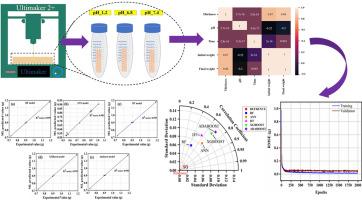刺激响应四维印刷单层弹性体条最终重量预测的集成机器学习方法
IF 8
2区 计算机科学
Q1 AUTOMATION & CONTROL SYSTEMS
Engineering Applications of Artificial Intelligence
Pub Date : 2025-10-15
DOI:10.1016/j.engappai.2025.112756
引用次数: 0
摘要
本文提出了一个集成的机器学习(ML)框架,用于预测通过材料挤压制造的四维印刷(4DP)单层弹性体条的最终重量。由聚氨酯(PU)、Eudragit®S100和聚乙二醇400 (PEG 400)组成的条带通过膨胀和热诱导转化来响应pH和温度。实验分析表明,初始权值与最终权值之间具有很强的相关性(r = 0.997),其中初始权值对预测精度的贡献为98.85%,而厚度仅为0.03%。使用设计属性(如厚度、pH值、肿胀时间和初始重量)对五种ML模型进行评估。决策树(DT)的准确率最高(> 99.95%),其次是随机森林(RF)和极端梯度增强(XGBOOST) (> 99.90%),优于人工神经网络(ANN) (> 98.30%)。所提出的框架强调了集成方法在捕获确定性关系方面的优越性能,通过将计算效率与高预测精度相结合,提供了比基于物理的模型明显的优势。本文章由计算机程序翻译,如有差异,请以英文原文为准。

Integrated machine learning approach for final weight prediction in stimuli-responsive four-dimensional printed single-layer elastomer strip
This paper presents an integrated machine learning (ML) framework for predicting the final weight of four-dimensional printed (4DP) single-layer elastomer strips fabricated via material extrusion. Strips composed of Polyurethane (PU), Eudragit® S100, and Polyethylene Glycol 400 (PEG 400) were engineered to respond to pH and temperature through swelling and heat-induced transformations. Experimental analysis showed a strong correlation (r = 0.997) between the initial and final weights, with an initial weight contributing 98.85 % to the predictive accuracy and a thickness of only 0.03 %. Five ML models were evaluated using design attributes such as thickness, pH, swelling time, and initial weight. The Decision Tree (DT) achieved the highest accuracy (>99.95 %), followed by Random Forest (RF) and Extreme Gradient Boosting (XGBOOST) (>99.90 %), outperforming the Artificial Neural Network (ANN) (>98.30 %). The proposed framework highlights the superior performance of ensemble methods in capturing deterministic relationships, offering distinct advantages over physics-based models by combining computational efficiency with a high predictive accuracy.
求助全文
通过发布文献求助,成功后即可免费获取论文全文。
去求助
来源期刊

Engineering Applications of Artificial Intelligence
工程技术-工程:电子与电气
CiteScore
9.60
自引率
10.00%
发文量
505
审稿时长
68 days
期刊介绍:
Artificial Intelligence (AI) is pivotal in driving the fourth industrial revolution, witnessing remarkable advancements across various machine learning methodologies. AI techniques have become indispensable tools for practicing engineers, enabling them to tackle previously insurmountable challenges. Engineering Applications of Artificial Intelligence serves as a global platform for the swift dissemination of research elucidating the practical application of AI methods across all engineering disciplines. Submitted papers are expected to present novel aspects of AI utilized in real-world engineering applications, validated using publicly available datasets to ensure the replicability of research outcomes. Join us in exploring the transformative potential of AI in engineering.
 求助内容:
求助内容: 应助结果提醒方式:
应助结果提醒方式:


